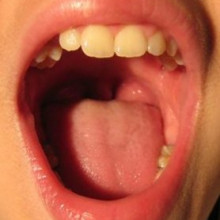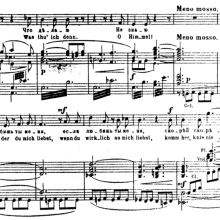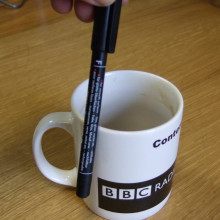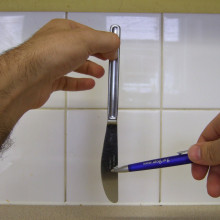Music Technology and the Science of Sound
Bringing music to our ears this week is Hugh Hunt who discusses the science of sound, how harmonics work and how to play music in a tea cup, Jez Wells describes the frontiers of music technology including recreating the sounds of a long lost cathedral, the secrets behind making a floboe, an instrument that is half oboe and half flute, and how to revive the sound of a castrati, a man with the voice of a choirboy. To compensate for the castrati's lost manhood, Bob and Chelsea look at cutting edge uses for testosterone in Science Update and Anna Lacey makes music with a long pink tube in Kitchen Science.
In this episode

- It's Good to Talk (But Gossiping's Better)
It's Good to Talk (But Gossiping's Better)
When friends get together, one of the things they love to do is gossip about others. And some research from Jennifer Bosson and her colleagues at the University of Oklahoma have found that bitching about others can actually help to forge friendships.
The study, published in the journal Personal Relationships, found that sharing negative feelings about a third person can bring people closer together than sharing positive feelings. Negative gossiping can even help to bring strangers together.
The researchers think that sharing bad gossip helps to boost self-esteem, and convey a feeling of belonging to a group or clique.
So while being a blabbermouth can have its drawbacks, it may help you to win friends - at least until they find out you've been rude about them behind their backs!

Going Nuclear
Our world is living under the threat of climate change and we're running out of fossil fuels fast. So how should we solve the coming energy crisis?
At the moment, the UK government is deciding whether we should build new nuclear power stations to cope with our rising energy demands.
But there are many complex issues involved - including the environmental, political, economic and scientific aspects.
To help make sense of it all, the Institute of Physics has asked three writers - including our own Dr Kat - to look into the issues surrounding nuclear power and new power stations.
Over the next ten weeks, the team will be detailing their investigations on a blog entitled Potential Energy.
You can check out their thoughts, and add to the debate yourself at www.potentialenergy.iop.org

- Making Music with Harmonics
Making Music with Harmonics
Mandy - Well now we're off to Ely in Cambridgeshire to join Anna Lacey for this week's Kitchen Science. She's with Wendy, Sophie and Hannah who are waiting to find out about harmonics and making music with nothing more than a pink tube. Hello Anna!
Anna - Hello and welcome to the King's School in Ely where this week we're going to be doing some more sound and music experiments. So on this evening we've got our helper with us today, our science guru Wendy. What are you here to do today?
Wendy - Well we're going to be doing an experiment with a rather simple but strange-looking musical instrument.
Anna - Yes it does look very strange and very pink too! We've also got our student helpers. Can you introduce yourselves, names and ages please?
Sophie - Hi I'm Sophie and I'm thirteen.
Hannah - Hi I'm Hannah and I'm thirteen.
Anna - And what's your favourite thing about science then Sophie?
Sophie - Probably the practical side of it.
Anna - And you Hannah? Are you a budding science Einstein?
Hannah - I like doing the practicals as well.
Anna - So Sophie, first of all would you like to describe exactly what Wendy's holding here?
Sophie - It's quite long and it's a very nice bright pink. It's got a lovely bumpy texture to it.
Anna - It kind of looks a bit like a corrugated elephants' trunk. And so Wendy, what is it you want these girls to do with this strange pink pipe?
Wendy - Well if you take an ordinary pipe and spin it around your head, you wouldn't expect anything much to happen. So maybe if we ask Sophie first of all to give that a try. Takw this pipe, which is a bit unusual, and spin it around and we'll see what result she gets from this experiment.
Anna - Ok, so we're all just going to stand back in order to make sure that nothing bad happens and Sophie is standing there holding the pink pipe ready to twirl it round her head like crazy. So, go Sophie! (Noise). So we're getting some kind of eerie noise. Sophie, what did it sound like to you.
Sophie - I realised that it stayed at the same note. It gave me the shivers really.
Anna - I noticed that when Sophie was twirling it round her head she was doing it at the same speed and we had a note there. So what we're going to ask you to do is to try it at a different speed. So Wendy, you're quite a pro at this. Do you want to give it a go at a different speed?
Wendy - After years of practise, let's have a go. Let's see if we can get the note that Sophie just got and then go a little bit faster.
Anna - So Hannah, what was the big change there? What did Wendy do differently?
Hannah - As Wendy speeded up it went higher and when she slowed down it went lower.
Anna - Now Wendy, why exactly was that?
Wendy - Well the main thing that's different about this tube in comparison to a bit of hose pipe is the corrugations on the inside of the tube. So it's a very bumpy tube, and those bumps are not just along the inside of the tube but also on the inside as well. So if you feel the inside, the inside's corrugated as well. So there's two things that need to happen for this tube to make a noise. Most people know that anything that's making a sound is doing so because something is vibrating. What happens is, when I spin the tube around my head, the one thing that you'll notice is the long end furthest away from me is spinning much faster than this end that I'm holding.
Anna - So there's lower pressure near the far end of the tube.
Wendy - Yes because it's moving fast. So what you've got then is a pressure difference and the air is moving through the tube. With most musical instruments you get air moving through the tube by perhaps blowing it, but this is a different way of moving if you like. The most important thing is the corrugations. As the air is travelling through the pipe, it's getting to wider parts and narrower parts all the way along the tube. So effectively the air is getting jiggled about and very turbulent. It's this jiggling and turbulence that starts the vibrations and causes the sound.
Anna - So what's happening is while you're twirling that around like a helicopter, there's a pressure difference between the end near your hand and the end at the far end of the tube which pulls air through like a wind tunnel. But then the air doesn't move through slowly, it actually gets jiggled about and that makes a noise. So why does it change then when you do it at a different speed?
Wendy - There's a certain number of vibrations that you can set up in this length of tube. So the speed that you're vibrating the air at affects the number of waves you can fit into this tube. If you've got that happening in air, what you hear are these specific different notes. You can't get every notes of the scale; you can only get certain notes.
Anna - Ok, so does this have anything to do with harmonics?
Wendy - Yes, that's what these basically are. We're listening to the harmonics of a pink tube instrument. Many musical instruments have this and many musicians will know these notes as the harmonic series and lots of people who play instruments have the ability to change the harmonics they hear by just tightening or changing the way their lips vibrate.
Anna - So musicians are actually performing proper sound science every time they pick up an instrument. That's just amazing if you ask me. But something even more amazing than that, Wendy, you can actually play a tune on this amazing tube.
Wendy - Yes, it's something to be very proud of after seven years of practising. I've put together five notes that I can get out of this tube, and if you put them together in a certain order, hopefully I can make a tune that some of the listeners might recognise.
Anna - For your listening pleasure, Wendy from Science Made Simple plays us a tune with a pink pipe. (Tune) So can you just enlighten us as to what the tune actually was.
Wendy - Yes it was the last post which you often hear played on a bugle on Remembrance Sunday.
Anna - That's absolutely wonderful. So what did you think of that Sophie?
Sophie - Excellent. I don't know how she does it?
Anna - And what did you think of the science behind all that?
Hannah - I thought that was very interesting how she can make a song out of just one pipe.
Anna - It's true. You heard it here first on the Naked Scientists in our Kitchen Science. Well that's all for this week. Thanks very much to Wendy, Sophie and Hannah and the King's School in Ely. We'll be back next week at another school in the Eastern Counties for some more Kitchen Science. Goodbye.

- Three New Planets Around Star Hd69830
Three New Planets Around Star Hd69830
with Dr Christophe Lovis, Geneva Observatory
Chris - Well HD69830 might not be the most excitingly named star in our cosmic neighbourhood but it's certainly got researchers buzzing in Switzerland, because Christophe Lovis and his colleagues at the Geneva Observatory have found in orbit three rocky planets about the size of Neptune. They're too small to see directly; in fact it was the wobble they provoke in their home star that gave them away. But intriguingly, at least one of them is in the habitable zone, like the Earth, and that means that it might also be a home for liquid water.
 Christophe - We have discovered a multi-planet system with three very low mass planets and it's the first such system with such low mass planets and, of course, we are now beginning to discover planets that are only a few Earth masses in mass, so we are approaching planets of a really small size and its become very interesting.
Christophe - We have discovered a multi-planet system with three very low mass planets and it's the first such system with such low mass planets and, of course, we are now beginning to discover planets that are only a few Earth masses in mass, so we are approaching planets of a really small size and its become very interesting.
Chris - So, you're into the kind of size which is almost Earth-like and, therefore, very similar in terms of their capacity to support life perhaps?
Christophe - Yes, for example. So we are not sure now what is their exact composition, but of course if the mass is very low then these planets are very likely to be mostly rocky and in that case they would really look like the Earth.
Chris - So, where are these planets?
Christophe - They are around a nearby star. This is quite a bright star that can be seen with the naked eye and it's about 40 light years away from the earth and so these three planets are orbiting this star, which is quite like our sun, a little bit less massive, a little bit cooler, but still much like our sun.
Chris - And how did you actually make these observations?
Christophe - We used dedicated instrumentation which was developed with the goal of being able to discover possible extrasolar planets by measuring, very precisely, the radial velocity of the stars. All stars are moving across space and each star has its own velocity in space, and so when observed from the Earth we can measure the component of this velocity along our line of sight. So some stars are just receding from us and some stars are approaching. And on top of that, when they are orbited by planets, these planets will induce a little gravitational wobble on these stars and they will make oscillations around their centre of mass velocity and we are able to measure these very tiny radial velocity changes.
Chris - So you saw this star, literally, wiggling a bit in space?
Christophe - Yes.
Chris - But if it wiggles a bit, how do you know there's three planets then if you can't see them?
Christophe - The signal curve by a planet is expected to be like a sinusoid curve and when we observe this star we noticed that the radial velocity showed complicated changes that could not be only explained by one sine curve and after accumulating enough measurements and trying orbital solutions, we found that the best solution was when we fitted three planets on these radial velocity curves.
Chris - And where are these planets, in relation to the star itself?
Christophe - The first one orbits with a period of nine days, it is very, very close to the star. Much closer to the star than, for example, Mercury in our own Solar System. Then the second planet orbits in 30 days which is a little bit further away and, most interestingly, the third planet which orbits in about 200 days which becomes quite similar to the Earth and so it's about 60% of the Sun/Earth distance.
Chris - Is that within what we call the habitable zone, for this particular star then?
Christophe - Yes, for this particular star it would be at the inner edge of the habitable zone so that means just at the border where the temperature is low enough for water to become liquid and that's one of the definitions of the habitable zone.
Chris - Do you think there is water there? Or do you not know anything about the composition of these particular planets?
Christophe - At the moment we have to be very careful. From the observations we have now published, we cannot say anything about the composition of these planets but we have made some theoretical calculations that show these planets, actually the first two, are mainly made of rocks and the second one and the third on also contains a lot of ices, that means there is a lot of water, but this water is not necessarily in the liquid form, it could be in ice.
Chris - I guess we'll just have to watch this space for more fertile findings from HD69830 and its clutch of rocky worlds. That was Christophe Lovis from the Geneva Observatory describing the work he's published in this week's edition of Nature.

- Science Update - testosterone
Science Update - testosterone
with Chelsea Wald and Bob Hirshon
Mandy - Now we're going to take our weekly trip over the ocean for a Science Update from Chelsea Wald and Bob Hirshon. This week they're going to be looking at the king of all hormones, testosterone, including its potential use in stopping the progression of MS and how too much of it may lead some birds to an early grave.
Chelsea - This week for the Naked Scientists we'll be talking about testosterone. Although it's present in both sexes, testosterone is commonly known as the male hormone. That's because males have more of it and it strongly influences male sex traits and mating habits. Now a study in birds shows that extra testosterone can give males a leg up in the mating game at a big price.
Bob - Would you die younger for a better sex life? Well that's what extra testosterone does for birds called dark - eyed juncos. North Dakota State University biologist Wendy Reed and her colleagues found that when young male juncos were treated with extra testosterone, they attracted older more fertile females, had more extra-marital sex and fathered more offspring than untreated males. But Reed says that attracting more mates also seemed to attract more predators.
Wendy - They also have a lower immune function than control males. And so they paid a cost that actually lowered survival rates.
Bob - What's more, their offspring were smaller and weaker than normal and the testosterone-treated dads tended to skip out on their parenting duties. Reed says that factors like these may keep junco populations natural testosterone levels in check.
Chelsea - And testosterone levels not only gives human males hairy chests, deep voices and an insatiable appetite for… sports, it may also protect them from multiple sclerosis. Men get the auto-immune disease less than women and when they do, it's often when their testosterone levels have dropped with age. So a team from the University of California Los Angeles had ten men with MS rub a testosterone gel on their skin every day for a year. The team then tested their brain processing speed and memory. Neurologist Nancy Sicotte says the result was an improvement on all counts.
Nancy - And in general in people in MS we would have expected to see a decline in those abilities because that's typically what happens. So it suggests that not only could they not get worse but they might actually have some improvements.
Chelsea - If they can confirm this effect in larger studies, this treatment could be the first to protect MS patients from brain damage. It wouldn't be suitable for women because of the side effects but the same team has found that the pregnancy hormone esterol could work for women.
Bob - Thanks Chelsea. Well you've heard of cyber gambling and cyber sex: next week we'll be talking about a new project that will let anyone with an internet connection dissect fish.
Chelsea - Until then, I'm Chelsea Wald.
Bob - And I'm Bob Hirshon for AAAS, The Science Society. Back to you Naked Scientists.

- The Science of Sound
The Science of Sound
with Dr Hugh Hunt, Department of Engineering, University of Cambridge
Dave - Today we've got Hugh Hunt from the Engineering Department at Cambridge University in the studio and he's now holding a normal kitchen knife. What are you going to do with that?
Hugh - We've just heard from Ely about harmonics which you can get from this tube. Well actually if you listen around pretty much anywhere you can find harmonics all over the place. I've got an ordinary eating knife, not one of those dangerous ones you don't want to be holding by the blade, and if I tap it like this I can get a nice note. I'm holding it roughly half way along. But if I hold it somewhere else I can get a different note. So depending on where you hold it, you get different notes. If you hold it right at the end, you don't a note at all.
Kat - So that's holding it at the very tip of the blade.
Hugh - Yeah, holding it at either end you don't get any note at all. But it's quite interesting to explore where you have to hold a knife to get these notes.
Dave - I see you've got a big aluminium tube behind you. Is that a bigger version of the same thing?
Hugh - It is. As ever, it's always much easier to demonstrate these things cleanly if you have a contrived perfect experiment. So I've got a tube here that's six foot long.
Kat - It's like a scaffolding post isn't it?
Hugh - It is. It's hollow inside so you can play it like a digeridoo as well but I won't do that now. If I hold it at the end it just goes thwack. It doesn't do anything. But if I hold it in special places I can get really nice notes. I can get this one….
Kat - So you're holding it about half way up.
Hugh - There are lots of different places. I've marked this tube with different coloured strips so I know exactly where to hold it. Now this is getting the fifth harmonic, so it's starting from the very bottom and going up the harmonic series, a bit like that pipe we heard before with its harmonic series. If I hold it somewhere different, I can get the sixth one up, which is a bit higher. And I can get the seventh one holding it even higher. I can get the fourth one here.
Dave - So what's actually happening to the tube when you hit it?
Hugh - Well the tube is vibrating. If you imagine you've got a long piece of spaghetti, not cooked spaghetti, and you could bend it into the shape of a letter C. Well if you imagine that that piece of uncooked spaghetti was floating around in space, it could vibrate backwards and forwards like that letter C. If you used three fingers, you could bend it into the shape of a letter S and it would vibrate backwards and forwards in the shape of the letter S. You could go one step further and bend it into the shape of a squiggly letter or number three with another bit in it and you could make it really serpentine. It turns out that every time you introduce more bends, there's more energy in it and a higher frequency. That's the same with light. You might know that energy goes up with frequency.
Dave - So the pitch gets higher the more wiggles you have in the rod.
Hugh - That's right. So all I'm doing with these marks on the tube here is noticing that I can pick out these different harmonics.
Dave - So basically where you're holding the rod, the rod can't be wobbling.
Hugh - That's right. It's called the nodal point. And so the fifth harmonic on this rid has six nodal points and the sixth harmonic has seven nodal points and so on. If you draw a letter S then it has three spots that go through the metal and the C has got two spots.
Kat - So you can do that, for example, on a guitar. If you very gently put your finger against the middle of the string. Is that the same principle when you get a high pingy sound?
Hugh - That's exactly the same. When you're playing a stringed instrument such as a guitar, a cello or a violin, you can play the note and then just touch it in the middle and you'll get an octave higher. If you touch it a third of the way along, you get an octave and a half higher. This is all the harmonic series. The reason you heard The Last Post being played before in Kitchen Science is because it uses the harmonic series.
Dave - So what Wendy was doing with the tube was driving different harmonics at different times to make the tune.
Mandy - And Hugh, interestingly enough if you go into a guitar shop to buy a new guitar, the first thing you do is test the harmonics because that will tell you whether the bridge is true or not.
Hugh - Absolutely right. Harmonics are so wonderful that composers throughout the centuries have used them in all sorts of ways. There's a wonderful bit in Brahms' first symphony that just uses harmonics played on the horns. It's just magic.
Dave - Is this because it's hard to play anything but the harmonic series on a horn?
Hugh - Well yeah. If you want to tell your kid not to play any instrument, don't tell then to play the horn because they're the ones that get the blame when things go wrong in the concert.

- Music Technology And Recreating Sounds
Music Technology And Recreating Sounds
with Jez Wells, Department of Electronics, University of York
Kat - Now we're going to chat to Jez Wells from the Electronics Department at the University of York. Jez and his colleagues are doing some really fascinating work into how we can recreate sounds that don't exist anymore. Tell us about it.
Jez - There are two ways you can think about sound. You can either think about sound as it arrives at the ear or you can think about sound as it is being made by an instrument. We look at both aspects; we look at physical modelling and spectral modelling of sound. Spectral modelling is all about sound and the nature of sound as it enters the ear. Physical modelling is all about the nature of sound as it is created by an instrument. When we are trying to create a physical model of guitar string we are interested in how long it's going to take a sound wave to travel down a string, up to the bridge of the guitar and then what's going to happen to that sound wave when it gets to the bridge. So some of it's going to be reflected back down the string and some of it's going to be passed on to the body of the guitar. So when we're building physical models of instruments, what we're interested in doing is working out how all these physical components of an instrument actually fit together and interact to create sound. Once we've created a physical model, what we then have to do is excite it. That means usually plucking it if it's a stringed instrument or blowing it if it's a bottle or a flute. Then what we're interested in doing is hearing. We need to put a microphone somewhere round our physical model. When we've put that microphone near to it, we might put it near one part of it to get one type of sound or another part to get another part. This is what recording engineers do all the time when you're miking up a guitar or a harp or something like that, you're always interested in getting the best noise. What we can do is you can take a physical model, which is a one dimensional physical model when waves are moving up and down the string. We can look at that in two dimensions by creating a mesh, if you like.
Kat - Are these all computer models?
Jez - Yes, computer-based models. So they're all imagined. Another important aspect of physical models is interacting with them, because having these things trapped inside a laptop isn't much fun. Interfaces and how we analyse human gestures and make them into musical gestures is another important part of physical models. But yes, the models themselves actually reside in the imagination of the modeller and inside the memory and processor of the computer.
Kat - So you've brought along some examples of your work today.
Jez - Yes, this is work that's been done by one of my colleagues, Dr Damien Murphy, who's been working on three-dimensional physical models. Now the great thing about three-dimensional physical models is that we can actually start to imagine spaces as opposed to one dimensional things such as a piece of string or two dimensional things such a the skin of a drum. Now the great thing about being able to manage spaces is that if you're an architect, you don't have to wait until the final bit of carpet is rolled out in your auditorium until you find out whether it sounds any good or not. Rather than having to build a small model, which used to happen, we can now put the architectural design into a computer and it imagines it is air sitting inside that space. Normally we're interested in an impulsive sound such as the clapping of hands and quite often we start of with a gun sound. We're interested in how the building responds. What happens when a gun is fired is that sound waves begin to move through the air particles. This is one reason why in a vacuum we can't have sound. It has to have a medium to travel through. But then it reaches certain objects: people, walls, that kind of things. Some of it will be absorbed and some of it will be reflected back and that's dependent on the nature of the sound, the frequency of the sound and so on. What we've got in this three-dimensional modelling is that we can say that even though this building doesn't exist, what would it sound like? This is quite handy for buildings that have been destroyed by fire or by warfare and for buildings that haven't yet been made.
Kat - We've got an example here, which I gather is the sound of Coventry Cathedral before it got blown up.
Jez - Yes, that's the old Coventry Cathedral. There's a fully functioning new Coventry Cathedral but the old one was destroyed during the Second World War. So what you'll hear is the impulse, actually, that's a choirboy. That was recorded in an anechoic chamber, which means a room without any echo at all. I hope what we'll hear next is what sounds like a gun being fired in a large space. Now what we're going to do is by a process known as convolution, combine the sound of the chorister with the sound of Coventry Cathedral. This is what this chorister might have sounded like had they been able to sing in Coventry Cathedral before it was destroyed.
Kat - Lovely. Not the sound of a chorister being shot, which I'm worried it might have been. We've got some other sounds here. You're working on how to combine the noises of instruments to make entirely new sounds.
Jez - Yes, having just talked about physical modelling I'll talk a bit about spectral modelling where we're interested in the make up of sounds. Hugh was playing different harmonics from a pipe. What happens when you combine those harmonics is the sound of an instrument. The reason that we can tell the difference between a trumpet and a violin playing the same note for the same duration at the same loudness is because the relationship between the harmonics, the loudness of the harmonics is different. So with spectral modelling what we're able to do is break sounds down into these fundamental ingredients. It's a little bit like taking a cup of coffee and being able to work out how many sugars it's got in it and how much milk it's got in it and what the coffee beans were. Then you can begin to say, well what would happen if I added ten sugars or what would happen if I took all the milk out and added cream instead? So one of the things I'm interested in is creating sound hybrids. One of the things I've produced is something called a floboe. A floboe is what would happen if a flute and an oboe were to get together and have a baby instrument. The idea is not to combine the two sounds so that it sounds like two instruments being played, but so they're somehow being fused together. In physical terms, what we're doing is taking the excitation part of the oboe, which is the reed that vibrates, and we are imposing it on the resonant structure of the flute. We've also got some of the breathiness of the flute thrown in for good measure as well.
Kat - Right, let's hear this. So we've got the flute. And now we've got an oboe. Which in my opinion sounds like a duck dying. Hopefully something more beautiful is a floboe. You can really hear the two different characteristics.
Jez - Well that's the idea. A lot of people expect music technology to be about amazing swooshes and amazing synthetic zap sounds. But actually music technology has hopefully now started moving into an area where those kind of special effects can still be had but we can move into creating sounds which are much more acoustically plausible that sound like they could have been made by a real physical object. It's slightly unflattering having it in an anechoic chamber like that, and it's great for us to analyse sound, but it's not so great for general recordings. Then you'd want a nice big auditorium such as a cathedral.
Kat - And the final example you've brought for us is something that really doesn't exist anymore, and that's the sound of a castrato. Now how did you make this?
Jez - Well this was for a programme that is going to be on BBC 4 some time this summer. It's a series about the 18th century and they wanted to make a programme about castrati.
Kat - Tell us briefly what castrati are.
Jez - Castrati are boys that had exceptionally good voices and were selected for castration. It was more of a snip rather than a hack although I'm sure that wasn't much consolation. It's not quite as brutal an operation as some people have thought that it might have been. However, the reason that that was done was to preserve their vocal folds or vocal chords. That would prevent their vocal chords from thickening and elongating during adolescence, but the body itself would continue to grow and the mind would continue to grow, so all those years of training would pay off. So what you end up with is a man with a large vocal tract and a huge power supply, a big pair of lungs, in control of a pre-adolescent's vocal folds.
Kat - So let's have a listen to this. We have first the sample of a tenor.
Jez - Yes this is a sample of a tenor singing a Handel aria that was written for castrati (sound).
Kat - Now we have the sound of a treble.
Jez - Now the treble is singing this an octave higher and the idea is that we really want the resonant structure, the lungs and the vocal tract of the guy we just heard, but we want the vocal chords or the excitation of the guy we're about to hear (sound).
Kat - And now we're going to hear them both together (sound). That's incredible.
Jez - It's still work in progress. There are a few wobbles there and one of the difficulties that we're having is that a boy's voice tends to be very breathy because they don't have the same kind of control as an adult singer. So we need to find ways of removing that breathiness. The final version should be aired some time over the summer.

- How long would a flip in the Earth's magnetic field take, and how might it affect technology?
How long would a flip in the Earth's magnetic field take, and how might it affect technology?
We don't really understand the Earth's magnetic field. We think it's produced by something to do with lots of molten iron flying around in the Earth's core. It's really difficult to model and on average it seems to flip about every quarter of a million years. It's been a million years since the last one flipped, so we think we're probably about due for one. This magnetic field does all sorts of things. It protects the atmosphere from the solar wind which is lots of particles being thrown off from the sun. They get caught by the magnetic field and get thrown off to the North and South Poles. This is what causes the Aurora Borealis or the Northern Lights. If the Earth's magnetic field flipped, it would probably almost disappear and start changing round, so we'd all get Northern Lights. It would have some negative effects though. It might have some effects on the climate because it would heat up the top of the Earth's atmosphere and it would do things like stop radio communications.

- Why does blowing across the top of a bottle make a sound?
Why does blowing across the top of a bottle make a sound?
I have a bottle hear so I can demonstrate this for you. First of all, I'm going to blow a note. Now we all know that if we put a bit of water in the bottle, we expect the note to go up because there is less air in the bottle to vibrate. If there is less to vibrate, then you get a higher note. Now the question is, if I squeeze the bottle and make it smaller, surely the note should also go up. But what happens is that it goes down. If I take the squeezed bottle and lower it into a tub of water, it goes up again, and this gives us a clue. When the bottle is perfectly round, we know that round things are stiff and solid. That's why pressure vessels are round and why a coke bottle with pressure in it is round. That's the strongest shape. But when you squeeze it you make the sides flat and that makes them weak. So actually you can tell when you put your finger on the side of the bottle, you'll actually be able to feel the flat bits vibrating a lot. That means that the bottle has an effective size that is bigger than it really is because it's moving some of the space around it. So the note goes down.

Could sound waves be heard on Mars?
There are two questions here. One is if we had a very loud screaming baby on the Earth, would somebody on Mars in theory hear the baby screaming, or would you need to have some interplanetary baby monitor? The answer is no, you wouldn't be able to hear the sound from Earth on Mars because the space in between Earth and Mars is a vacuum. There's a wonderful experiment you can do where you put an alarm clock under a bell jar and you start a vacuum pump going. You then stop hearing the bell even though the bell is still going. But then the question is, well what if your baby was in the bedroom in your Mars planetary home? Would you be able to hear the baby crying from downstairs in your bedsit? The answer would depend very much on the atmosphere on Mars and my understanding is that there's not very much atmosphere: about 1% of the atmosphere on Earth, so it's getting close to a vacuum. So there are two things: the amount of energy that you can pump into the atmosphere is less; and also the speed of sound would be a lot faster.

- When I play my flute, sometimes it gets a really screechy noise. What is it?
When I play my flute, sometimes it gets a really screechy noise. What is it?
Instruments are quirky things. It's a bit like cars; you might be driving along and when you go 57.5 miles per hour, the steering wheel starts to wobble. That's just a particular characteristic of your car. Some things you can fix and other things you can't. Some of you who play the cello or others stringed instruments might know about the wolf note: there's a certain note that just does funny things. It could be that it's an interaction between the acoustic mode or the note you're playing which is all to do with the air, and the actual structure of the flute such as it being made of metal. That's very important. You can think of a saxophone and a clarinet: a clarinet is made of wood and a saxophone is made of metal. That's essentially what makes the instruments sound quite different. So there is an interaction between the sound, the air and the metal and maybe that's why you pay an extra £500 for an ultra good flute.

- Is white noise something to do with gravity or the big bang?
Is white noise something to do with gravity or the big bang?
If I play a nice pure tone, then that's got a particular frequency. But if I were to play all notes together, then that starts to become what you might call noise. Let's imagine that you played every single note that you can possibly imagine, which would not only be the white and black notes on the piano, but all the notes in between. In acoustics we would call that white noise. It's not just sound where you find vibration. You find vibration and waves in the surface of water, light is a wave, you'll find waves in slinky springs, and all over the place. You may have heard of things like the cosmic background radiation. Actually these are all electromagnetic waves of various kinds and light can be as much white noise as anything. So the reason it's called white noise is because we know that white light is made up of all the colours of the rainbow; lots of frequencies all at once. So white noise is taken from white light. When there was the big bang all sorts of frequencies were emitted. The noise from the big bang had one peak frequency so it's not all the frequencies at once and so it probably isn't really white noise.

- Why do instruments from different countries not sound good together?
Why do instruments from different countries not sound good together?
One of the reasons is that not all instruments are harmonic. If you were to take the example of a Javanese gamelan, they use a lot of metallophones. Because they are metal bars, they don't strictly have harmonics. In fact they're what we call partials. Rather than having a frequency at which they vibrate and harmonics above that of one, two three or four times, the modes of vibration are no longer integer multiples, so 1.54, 1.76. Hence they make a wonderfully rich sound. But when we play them with other instruments that are harmonics, the harmonics and the partials don't coincide with each other and that causes a very confusing pattern of vibration inside the cochlea and the inner ear. It's this which leads to problems with tuning between these two different instruments.

What is ultrasound? Is it actually sound?
Ultrasound is sound but it's got such a high frequency that you can't hear it. It's so high and the wavelength's so small that you just can't hear it.
Related Content
- Previous Science of Happiness
- Next BSE, Cervical Cancer and Toxoplasmosis











Comments
Add a comment